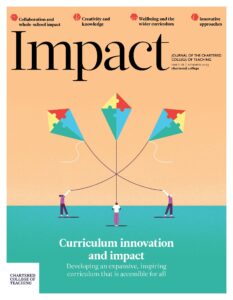Curriculum alignment: A reflection of its place in a school curriculum

Ngozi Oguledo, Lead Practitioner, Ortu Gable Hall School, UK
What is curriculum?
The term ‘curriculum’ has been derived from the Latin word currere, which means to run a course (Pinar, 2012). Considering curriculum in this way suggests that it will consist of an aim, a pathway taken to achieve the aim, and steps to ascertain that the aim has been actualised. Kelly (2009) argues that any definition of curriculum should ideally include the content knowledge to be embedded, the purpose for such transmission and an exploration of the intended outcome. In other words, curriculum encompasses aims, content, pedagogy and assessment. Kelly (2009) further points out that curriculum must embrace all the learning to which students are exposed in schools, whether it is explicitly intended or is a spin-off from the planning and/or practices employed in the delivery. Similarly, the Department for EducationThe ministerial department responsible for children’s services and education in England has described the school curriculum as the totality of learning and other experiences that schools provide for their students (DfEDepartment for Education - a ministerial department responsible for children’s services and education in England, 2014). To put it simply, curriculum sums up the learning experience of students.
Curriculum alignment
A review of different sources indicates that there are different forms of curriculum. The written or intended curriculum outlines that which society deems important to learn, and the enacted or implemented curriculum is that which is delivered in the classroom (Phaeton and Stears, 2017; Porter, 2004).
Alignment in education entails clarifying the relationship between what students experience in their course and what they are expected to learn (Allen, 2004). It helps to reduce the discrepancies between the intended process and the actual process (Wenzel, 2016). Roach et al. (2008, p. 160) defined alignment as ‘the extent to which curricular expectations and assessments are in agreement, and work together to provide guidance for educators’ efforts to facilitate students’ progress toward desired academic outcomes’. This implies that curriculum alignment plays a large role in ensuring consistent and robust curriculum delivery across the school, thereby improving the quality of students’ school experience. Furthermore, Watermeyer (2011) considers curriculum alignment as a term that sums up the relationship between content validityIn assessment, the degree to which a particular assessment measures what it is intended to measure, and the extent to which proposed interpretations and uses are justified, content coverage and the opportunity to learn. In other words, curriculum alignment encompasses the totality of the links between the various elements of the students’ learning experience.
With curriculum alignment, the gaps between intended curriculum, instruction and assessment can be minimised. This would arguably not only enhance students’ performance and achievement, but would also aid teachers’ understanding of what students know and can do (Kurz et al., 2010, Wenzel, 2016).
Concerns about alignment revolve around the extent to which the different curricula contents overlap, and to what degree they serve together to enhance students’ learning (Kurz et al., 2010). Poor curriculum alignment can create a disadvantage for students aiming to acquire new knowledge and skills (Shaltry, 2020), as a lack of curriculum alignment can create gaps in students’ learning. For example, when content is missed out or not properly delivered in the previous year due to poor alignment, it creates a gap that limits the understanding of the new content, thereby impeding subsequent learning, Consequently, there is a need to promote curriculum alignment in schools.
Challenges with curriculum alignment
One of the challenges with curriculum alignment is achieving successful teacher buy-in (Wenzel, 2016). Jones and Leagon (2014) point to factors such as teachers’ prior knowledge and experience, self-efficacy, epistemic belief and the sociocultural context of the teacher and school affecting the construction and change in teachers’ behaviour. This suggests that teachers’ behaviour is influenced by their experiences, knowledge, abilities, beliefs and their school community. In view of this, factors affecting curriculum alignment will be considered under three dimensions: teacher-induced, curriculum-induced and school-induced factors.
Teacher-induced factors
Teachers play an essential role in the implementation of the curriculum. Teachers’ understanding of curriculum, their attitude towards it and their self-efficacy in the ability to contextualise the curriculum contents, can have an effect on curriculum alignment (Bay, 2016). Typically, teachers may rely on their knowledge and experience of delivering a curriculum in the past to inform the delivery of a new curriculum – for example, a teacher delivering the new GCSE content based on their knowledge of the old GCSE specifications. Their experience could result in a better understanding of why and how to align curricula, or it could impede the opportunity to align as they could be stuck in their old ways. Their interpretation of the curriculum can also be a contributing factor. Teachers’ belief of what the curriculum is can affect their interpretation of it (Phaeton and Stears, 2017). Where interpretation misaligns with the intended curriculum, there is the possibility of a weak adoption of the curriculum.
Experience in the form of teacher subject knowledge and familiarity with the intended curriculum can influence the enacted curriculum (Kurz, 2011). Teachers require both content knowledge and pedagogical content knowledge for effective teaching (Coe at al., 2014). If a teacher is deficient in one, the ability to translate the curriculum into suitable learning activities for students becomes limited.
Curriculum-induced factors
The nature of the written curriculum can be a hindrance to its effective implementation. Vague curriculum statements open up different interpretations of the intended curriculum (Phaeton and Stears, 2017). These interpretations can be influenced by the experience of the teacher, teachers’ conception of what the curriculum should be and their subject knowledge. With limited subject knowledge, especially when some teachers teach outside their specialism due to staff shortages, variations in the interpretation of the curriculum become unavoidable. This results in the varied delivery of the curriculum. The volume of the curriculum content can also play a part here. With the limited curriculum time available in some subjects and the demands of externally assessed subjects, teachers may be faced with the dilemma of selecting what is crucial in the intended curriculum. When there is a conflict between the externally assessed curriculum and school-intended curriculum, it is logical to argue that the assessed curriculum will inform the implemented curriculum.
School-induced factors
School factors, including the school structure, leadership system and the school climate, can affect curriculum alignment (Bay, 2016) – for example, when the school’s mission promotes a particular aspect of the curriculum more than others. This uneven promotion of certain elements of the curriculum may trigger gaps between the intended and implemented curriculum. It is rational to point out that when school leaders promote certain elements of the school curriculum over others, the latter is prone to ill-implementation.
Time constraint could be another factor affecting curriculum alignment (Wenzel, 2016). Effective curriculum alignment would require teachers working collaboratively to harmonise what they intend to deliver and how they intend to do so. However, time for curriculum development may not be readily available, as schools have to deal with other areas of their provisions. This is not helped by changes in national and school policies, which put a strain on time availability, as new policies require time for effective implementation. In addition to the time for curriculum development, curriculum implementation time may affect alignment. It is logical to argue that when curriculum time is limited, the implemented curriculum, particularly for exam groups, will closely match the externally assessed curriculum. The unassessed elements of the school’s intended curriculum are perhaps ignored.
Promoting curriculum alignment in schools
To ensure the full benefits of curriculum alignment, schools should provide opportunities for teachers to engage in curriculum-themed CPD. This can include engaging teachers in developing and reviewing curriculum aims, and developing curriculum alignment. Avenues to enhance teachers’ understanding of the need for curriculum alignment and how to achieve this should be made available. This can be provided through collaborative planning, peer observations and group work scrutiny. Such avenues provide teachers with the opportunity to clarify the intended curriculum and promote consistent ways of translating the intended curriculum to the implemented curriculum. This is beneficial, as teachers’ engagement in curriculum alignment can enhance their understanding of what to teach (both content and skills), their ability to choose the most effective way in which to aid students’ understanding of the intended knowledge and acquisition of the intended skills, and how to effectively assess them (Seitz, 2017). It is also reasonable to suggest that buy-in is promoted when practitioners have a better understanding of an initiative or process.
CPD programmes should be designed to tackle the connection between teachers’ beliefs, knowledge, attitudes and their classroom practice (Jones and Leagon, 2014). Engaging in developing curriculum alignment would provide opportunities for teachers to mull over their beliefs and conceptions of curriculum, and thus refine their practices. It would also provide the opportunity for collaborative work on curriculum development or discourse. Moreover, curriculum is not static but is constantly evolving (Watermeyer, 2011). As time for such discourse can be a constraint in schools, school leaders can support by providing protected time for curriculum-related events. For example, the departmental meeting times can effectively be used more for curricular and pedagogical development and less for administrative tasks.
In addition to good CPD opportunities, schools should also ensure that their curriculum is clear and easy to follow, with no ambiguous content – for example, having a scheme of work with clear objectives and opportunities to achieve them. This is because alignment is facilitated by clear and well-articulated educational goals (Breslawski, 2017). When curriculum is not clearly articulated, opportunities for misinterpretation arise and these lead to misalignment (Phaeton and Stears, 2017). Non-subject-specific areas such as SMSC (spiritual, moral, social and cultural development) and PSHE (personal, social, health and economic education) that are normally delivered as part of the school curriculum should be carefully reviewed and placed in areas where they are best suited. Schools should consider whether it would be beneficial to avoid a blanket rule on the implementation of such areas across the curriculum, since opportunities for their delivery may not be the same across the subject areas.
Furthermore, schools should look into having a well-resourced curriculum package to support its provision. The provision of a range of good resources such as textbooks, carefully designed PowerPoints and animations/videos related to the intended curriculum will help to facilitate its proper adoption. These teaching and learning aids will not only promote alignment, but also increase the consistency of the quality of provision offered.
Finally, schools should improve their stakeholders’ awareness of their curriculum. Good stakeholder understanding of the curriculum can contribute to better alignment. To aid this, schools should make their curriculum journey or map available to students and parents. This promotes a better understanding of the overall intended outcomes.
- Allen M (2004) Assessing Academic Programs In Higher Education. San Francisco: Jossey-Bass.
- Bay E (2016) Developing a scale on factors regarding curriculum alignment. Journal of Education and Training Studies 4(5): 8–17.
- Breslawski S (2017) Managing academic program resources. In: Powers K and Schloss P (eds) Organization and Administration in Higher Education. New York: Routledge, pp. 146–181.
- Coe R, Aloisi C, Higgins S et al. (2014) What makes great teaching? Review of the underpinning research. The Sutton Trust. Available at: www.suttontrust.com/wp-content/uploads/2014/10/What-Makes-Great-Teaching-REPORT.pdf (accessed 30 November 2022).
- Department for Education (DfE) (2014) The National Curriculum in England. Available at: https://assets.publishing.service.gov.uk/government/uploads/system/uploads/attachment_data/file/840002/Secondary_national_curriculum_corrected_PDF.pdf (accessed 28 November 2022).
- Jones M and Leagon M (2014) Science teacher attitudes and beliefs: Reforming practice. In: Lederman N and Abell S (eds) Handbook of Research on Science Education, vol 2. New York: Routledge, pp. 830–847.
- Kelly A (2009) The Curriculum: Theory and Practice, 6th ed. London: Sage Publications Ltd.
- Kurz A (2011) Access to what should be taught and will be tested: Students’ opportunity to learn the intended curriculum. In: Elliott S, Kettler R, Beddow P et al. (eds) Handbook of Accessible Achievement Tests for All Students. New York: Springer: pp. 99–130.
- Kurz A, Elliott S, Wehby J et al. (2010) Alignment of the intended, planned, and enacted curriculum in general and special education and its relation to students’ achievement. Journal of Special Education 44(3): 131–145.
- Phaeton M and Stears M (2017) Exploring the alignment of the intended and implemented curriculum through teachers’ interpretation: A case study of A-level biology practical work. Eurasia Journal of Mathematics Science and Technology Education 13(3): 723–740.
- Pinar W (2012) What is Curriculum Theory? 2nd ed. New York: Routledge.
- Porter A (2004) Curriculum Assessment. Nashville: Vanderbilt University.
- Roach A, Niebling B and Kurz A (2008) Evaluating the alignment among curriculum, instruction, and assessments: Implications and applications for research and practice. Psychology in the Schools 45(2):158–176.
- Seitz P (2017) Curriculum alignment among the intended, enacted and assessed curricula for Grade 9 mathematics. Journal of the Canadian Association for Curriculum Studies 15(1): 72–94.
- Shaltry C (2020) A new model for organizing curriculum alignment initiatives. Advances in Physiology Education 44: 658–663.
- Watermeyer R (2011) Curriculum alignment, articulation and the formative development of the learner. International Baccalaureate Organisation. Available at: https://purehost.bath.ac.uk/ws/portalfiles/portal/136642120/curriculumalignmenteng.pdf (accessed 28 November 2022).
- Wenzel A (2016) Curriculum alignment. In: Mertens S, Caskey M and Flowers N (eds) The Encyclopedia for Middle Grades Education, 2nd ed. Charlotte: Information Age Publishing, pp. 112–115.










